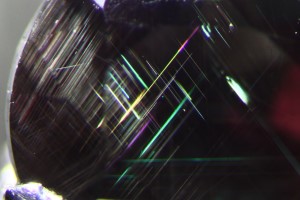Alexandrite is a color variety of the mineral Chrysoberyl. It was discovered in 1830 at the Takowaya creek in the southern Urals in Russia. For more than 150 years, the supply of this colorful gem originated from this single source. 1987 new and larger deposits were discovered in Hematita (Brazil). Today they produce more than 80 percent of fine Alexandrites of the global market. Economically less important deposits are located in Sri Lanka, Myanmar (Burma), Tasmania and Zimbabwe.

Rutile inclusions in a natural alexandrite reflect the light in bright colors
Foto: K. Sieber, www.makrogalerie.de
The special feature of alexandrite is the ability to change its color in artificial light. In daylight the gem always appears in green, bluish green or gray green colors. In artificial light with a priority of wavelengths in the yellow spectrum (e.g. candlelight) his color changes to blood-red or reddish violet. Responsible for this phenomenon is the element chromium which occurs - together with iron and titanium - as a trace element in the gem.
Fine Alexandrite, especially in sizes of more than one carat, is one of the most valuable gemstones. Its value depends primarily on the intensity of the color change. A very fine Alexandrite should be a vivid green in daylight and purple red without any brownish hue in incandescent light. The ability to change its color in different light sources is not limited to Alexandrites.
Imitations
Certain synthetic Sapphires change their color from violet in daylight to red violet in incandescent light. They are used in jewelry as Alexandrit substitution. This fake is widespread. A research conducted by the EPI laboratory in 2019 revealed that 90 percent of all "Alexandrite" jewelry offered on eBay, was made of this synthetic sapphire. The differentiation is quite easy: In daylight Alexandrite is ALWAYS green and never violet like the synthetic Sapphires. There is no exception to this rule. If you are being offered an "Alexandrite" which is violet in daylight, it's a fake.
Possibilities for confusion with other gemstones

Color changing Garnet: above in incandescent light, at the bottom in daylight
Foto: K. Sieber, www.makrogalerie.de
Some types of Garnet can change their color due to a minute amount of the element vanadium. The most common and inexpensive garnet with this characteristic has a chemical composition which lies between that one of pyrope and spessartite. Its color changes from greenish brown in daylight to pink brown in incandescent light. Usually it is sold as low-priced, faceted chain strands.
Even though these stones differ fundamentally from real Alexandrites in their physical appearance such as color, light refraction and density, they circulate on the market persistently under the misleading name "Alexandrite".
Some Garnets from Tanzania are offered as rarities since they change their color from green in daylight to red in incandescent light just like Alexandrites. The distinction can be easily made using gemmological examination methods.





